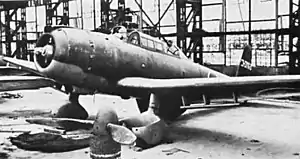Yokosuka D3Y
The Yokosuka D3Y Myojo (明星, "Venus") was a Japanese two-seat dive bomber/trainer designed and built by the Yokosuka Naval Air Technical Arsenal. Derived from the Aichi D3A, it was made nearly entirely of wood in an attempt to conserve valuable resources. Upon Japan's surrender, the project came to a halt with only a few aircraft delivered as the Navy Type 99 Bomber Trainer Myojo Model 22.
| D3Y Myojo | |
|---|---|
 | |
| Role | Trainer Dive bomber |
| Manufacturer | Yokosuka |
| First flight | 1945 |
| Status | Cancelled |
| Primary user | IJN Navy Air Service (Intended) |
| Produced | 1945 |
| Number built | 2 Prototypes 3 Production |
| Developed from | Aichi D3A |
Design and development
The D3Y was a two-seat bomber trainer constructed of wood, so as not to use more valuable materials. It was based on the successful Aichi D3A with design starting in late 1942. Like the D3A, it was a two-seat low-winged monoplane with a fixed tailwheel undercarriage. To allow construction by unskilled workers, the elliptical wing and rounded tail of the D3A were replaced by straight tapered alternatives, while the fuselage was lengthened to improve stability.[1] Two prototypes were built during 1944, but these proved heavier than expected. Three production aircraft, which were redesigned to save weight, were completed for the Imperial Japanese Navy Air Service before the end of the war, and designated the Navy Type 99 Bomber Trainer Myojo Model 22.[1]
Variants
- D3Y1-K Myojo (Navy Type 99 Bomber Trainer Myojo Model 22)
- A two seat wooden dive-bomber trainer. Powered by a 1,300 hp (970 kW) Mitsubishi Kinsei 54 radial engine, based on the Aichi D3A2-K, with significant changes to allow production in wood. Two prototypes and three production aircraft built.[1]
- D3Y2-K Myojo
- Single-seat special attack version (Kamikaze) of the D3Y1. The undercarriage would be jettisoned on take off since the aircraft was not expected to return. The prototype had begun construction, but was still incomplete, when the war ended.[1]
- D5Y1 Myojo Kai (Navy Special Attacker Myojo Kai)
- Production designation given to the D3Y2-K.
Specifications (D3Y2-K)
Data from Japanese Aircraft of the Pacific War[1]
General characteristics
- Crew: 1
- Length: 11.515 m (37 ft 9 in)
- Wingspan: 14 m (45 ft 11 in)
- Height: 4.2 m (13 ft 9 in)
- Wing area: 30.5 m2 (328 sq ft)
- Empty weight: 3,050 kg (6,724 lb)
- Gross weight: 4,630 kg (10,207 lb)
- Powerplant: 1 × Mitsubishi Kinsei 62 14-cylinder two-row air-cooled radial piston engine, 1,160 kW (1,560 hp) for take-off
- 1,000 kW (1,340 hp) at 2,100 m (6,900 ft)
- 890 kW (1,190 hp) at 5,800 m (19,000 ft)
- 1,000 kW (1,340 hp) at 2,100 m (6,900 ft)
- Propellers: 3-bladed constant-speed metal propeller
Performance
- Maximum speed: 470 km/h (290 mph, 250 kn) at 5,000 m (16,000 ft)
- Cruise speed: 296 km/h (184 mph, 160 kn) at 3,000 m (9,800 ft)
- Range: 1,472 km (915 mi, 795 nmi)
- Time to altitude: 6,000 m (20,000 ft) in 11 minutes 45 seconds
- Power/mass: 4.0 kg/kW (6.5 lb/hp)
Armament
- Guns: 2x 20 mm (0.787 in) Type 99 Mark 1 machine gun in the engine cowling.
- Bombs: 1x 800 kg (1,800 lb) bomb.
References
| Wikimedia Commons has media related to Yokosuka aircraft. |
- Francillon, Rene (1979). Japanese Aircraft of the Pacific War. London: Putnam & Company Limited. pp. 469–471. ISBN 0-370-30251-6.
Further reading
- The Illustrated Encyclopedia of Aircraft (Part Work 1982-1985). Orbis Publishing.